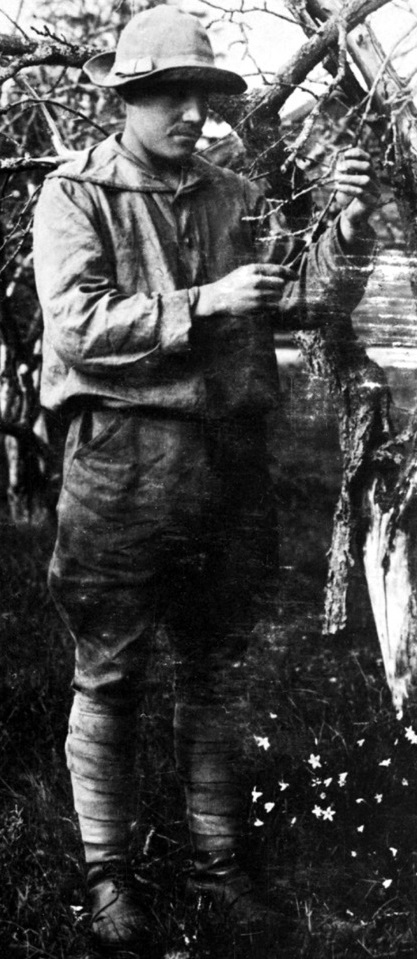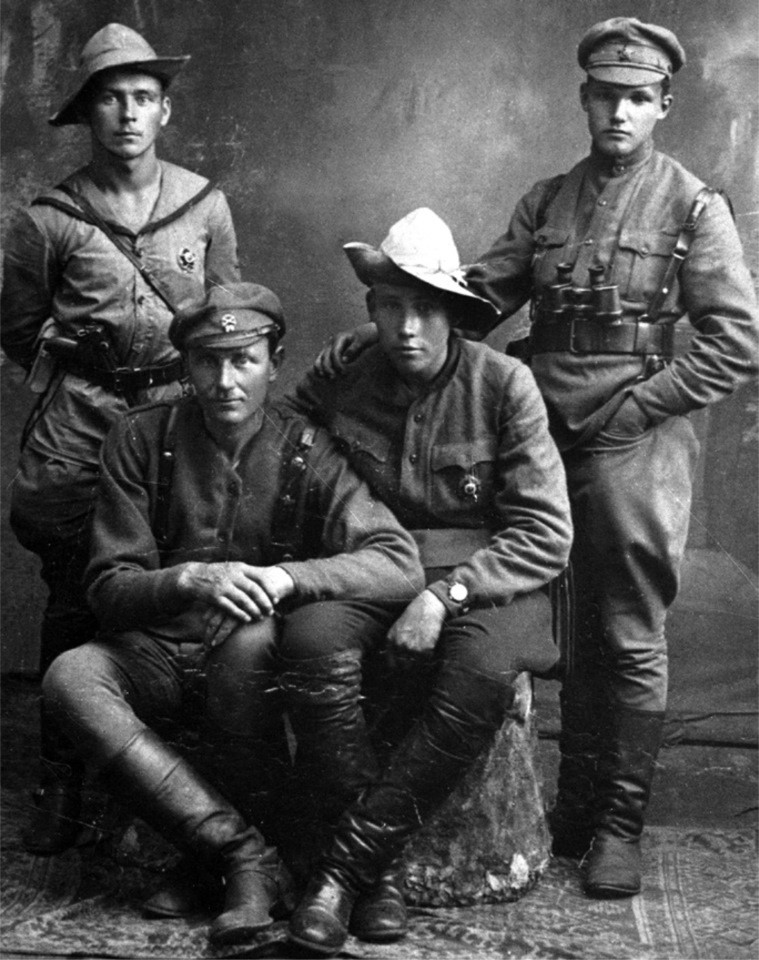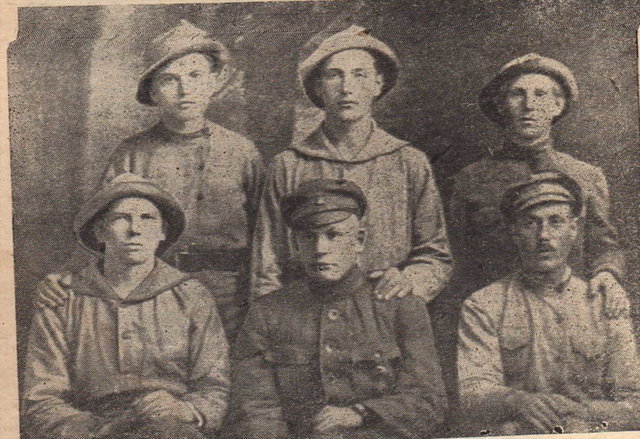
Red Estonian Rifles
In March 1918 Estonian Communists in Petrograd began to organise on the model of the Latvians. By August they had formed the 1st Tallinn Estonian Communist Rifle Regiment. Later in the year the Tartu Estonian Communist Regiment, the 14th Narva Estonian Communist Regiment and the 2nd Viljandi Estonian Communist Rifle Regiment followed. Keeping track is difficult, however, as they changed names and numbers several times.
The Tartu and Viljandi Regiments took part in the civil war in autumn of 1918, on the Northern and Eastern Fronts. At least one battalion fought near Miass in Siberia.
With the end of WWI, the Estonian regiments moved to take their homeland from the retreating Germans. The first fighting started in Narva in November 1918. With the capture of that city, the Estonian Soviet Republic was proclaimed. An Estonian Red Army was formed, and the Estonian communist regiments became a division.
The regiments were reorganised in two brigades in February 1919 as:
- 1st Estonian Communist Rifle Regiment, formerly the Tallinn Regiment
- 2nd Estonian Communist Rifle Regiment, formerly the Viljandi Regiment;
- 3rd Estonian Communist Rifle Regiment, formerly the Tartu Regiment
- 4th Estonian Communist Rifle Regiment, formerly the 46th Rifle Regiment. It was not in the Estonian Division, but instead in the 1st brigade of the 6th Rifle Division. In June 1919 it once more became the 46th Rifle Regiment;
- 5th Estonian Communist Rifle Regiment. This later (presumably June 1919) became the 406th Rifle Regiment, 136th Brigade, 46th Rifle Division;
- 6th Estonian Communist Rifle Regiment;
- Estonian Red Cavalry Regiment;
- Estonian Communist Artillery Divizion, with both light and heavy guns.
Strength at this time was 8,500 men.
Initially the Soviet advance went well and most of the country fell to them. But their opponents quickly regrouped. The newly formed Estonian national army had retaken Tartu by mid-January and Narva fell on 19 January. By February 1919 the Estonian Communist Regiments and the units of the Red 7th Army alongside them had been driven from Estonia.
The collapse of the Soviet offensive suggests that many of the Red Estonians, like the Red Latvians, were not happy to fight fellow countrymen. The division's commander, Lembit Ritt, appears to have defected for example. In June 1919 the "Estonian Red Army" was disbanded. It was sufficiently small to be reformed as the Estonian Rifle Brigade. Those left in the ranks were presumably committed Communists or Russians of Estonian origin, so they may well have improved in quality, despite the defeat.
They operated south of Lake Peipus – the northern sector around Narva was held by the Northern Corps of Rodzianko (later NorthWestern Army of Iudenich), and the southern sector is where the Estonian National Army was operating. Mostly it did not go well for the Reds. However, in August 1919 the Estonian Infantry Brigade recaptured Pskov, alongside the 10th Rifle Division and 11th Rifle Division (including the 1st and Composite Brigades with the 2nd Brigade of 3rd Rifle Division).
Eventually accepting that Estonia would not be taken, the Estonian Soviet Republic was disbanded, and the brigade pulled back. In September 1919 the Petrograd battalion of the Vsevobuch (worker training organisation, in this case Putilov workers) and the 86th Rifle Regiment were attached, and they were reorganised as a division.
The new division was transferred near Orel-Kromy to fight the advancing units of Denikin as part of the "Strike Force". We have a order of battle for that time. They were organised as three brigades, with the 3rd being Russians.
| Bayonets | Sabres | Staff | HMGs | LMGs | Guns | Horses | Men | ||
| 1st Estonian Regt | 423 | 22 | 51 | 3 | 4 | – | 162 | 891 | |
| 2nd Estonian Regt | 450 | 37 | 45 | 9 | 2 | – | 189 | 954 | |
| 3rd Estonian Regt | 440 | 19 | 43 | 6 | – | – | 123 | 726 | |
| 4th Estonian Regt | 434 | 36 | 37 | 12 | 3 | – | 267 | 896 | |
| Vsevobuch Regt | 1038 | – | 52 | 22 | – | – | 77 | 1695 | |
| 86th Rifle Regt | 462 | – | 41 | 12 | 1 | – | 76 | 939 | |
| 1st Estonian Battery | – | – | 6 | 1 | – | 4 | 70 | 200 | |
| 2nd Estonian Battery | – | – | 6 | 1 | 1 | 4 | 82 | 178 | |
| 3rd Estonian Battery | – | – | 7 | 1 | – | 3 | 79 | 171 | |
| Communication Company | – | – | 6 | – | – | – | 39 | 270 | |
| Sapper Company | – | – | 6 | – | – | – | 20 | 115 | |
| HQ | 99 | – | 12 | 1 | 1 | – | 42 | 156 | |
| Totals | 3 346 | 114 | 312 | 68 | 12 | 11 | 1 226 | 7 191 |
The "HQ" is the divisional staff, the Commander's Detachment and a Weapons Team.
The LMGs are listed as Avtomats.
The Estonian Cavalry Regiment had been detached to the NW Front.
The Vsevobuch may well be ChON, which was part of that system.
After that they fought Makhno's partisans, and then attempted unsuccessfully to storm the Perekop peninsular into the Crimea. Heavy losses in these actions (some claim that many defected during the Makhno operation) led to the division being disbanded in March 1920. The remaining men were placed into the 46th Rifle Division.
Commanders of the Division: L. Ritt (Mar - May 1919), J. Palvadre (May 1919 - Feb 1920), Yu. V. Sablin (Feb - Mar 1920).
Chiefs of Staff: A. Kork (Feb - May 1919), A Põld (May 1919 - Mar? 1920)
Military commissars: M. T. Laius (Mar - Jun 1919), P. A. Peterson (Apr - Jun 1919), A. Reimets (Jun 1919 - Mar 1920), I. Tamm (Jun 1919 - Mar 1920), E. Rips (Jun 1919 - Mar 1920).
There were also some "internationalist" Estonian units on the fronts of against Kolchak's army.
Uniforms
For most of their time the Estonians were dressed like most Red Army. Initially we know a lot of civilian clothes were worn, especially among those recruited in the initial stages of the invasion of Estonia.
While in Narva, however, they came across large stores, and for a while they had quite a different look. The infantrymen wore an open collared shirt and baggy pale green trousers. The most distinctive feature was the hat which was had a round crown and broad brimmed – turned up in a variety ways, but mostly at the front. Shoes and leggings were common. There was also a rain cape, rather than greatcoat. This uniform can be seen to the right:
The cavalry wore the trousers with two thin red stripes and boots. They likely wore normal furazhka caps, as more practical on a horse.
Officers seem to have mostly worn normal caps and blouses.
As time went on this distinctive outfit was replaced by more standard uniforms, but some were still in use when they were brigaded with the Petrograd workers and the 86 RR ( who wore entirely standard Russian uniforms, although the workers may have been in civilian clothes).
The Osprey Elite Series Armies of the Baltic Independence Wars 1918-1920, has some colour plates, including a commander the Estonian Rifles. I don't know the reference for all the red trim, but it seems reasonable. There is also a commissar, but he is in normal Red Army garb.

The distinctive uniform.

Judging by the pistols, field glasses and watch, these will be commanders.
The one with the watch has cavalry boots.

Again likely commanders. Note all the different ways of wearing the hat.

Included mainly for the banner, which is in Estonian ("Eesti" = Estonia).

Rank and file wearing the hat, some with the distinctive shirt as well.
Sources
Maamyagi V.V. In the Fire of Battle (the Red Estonian Rifles) M., Mysl', 1987
A full book treatment of the Estonian Division.
Siberia Miniatures has a thread, with a few extra photos. (Currently dead)